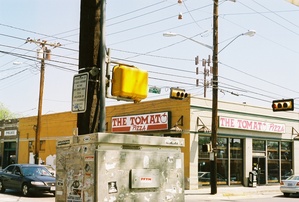Also see Timeline of Denton
Founding of Denton
The formation of the city of Denton is closely tied with that of Denton County. Unlike other neighboring cities in North Texas, there is no record of a large Native American population in the area before 1800. European settlement began in mid-1800s when William S. Peters of Kentucky obtained a land grant from the Texas Congress and named it Peters Colony. After initial settlement in the southeast area in 1843, the Texas legislature voted to form Denton County in 1846. Residents chose two different county seats (Pinckneyville and Alton) before voting on Denton as the final county seat in 1857. Both the county and the town were named in honor of John B. Denton, a preacher and lawyer, who was killed in a 1841 battle led by General Edward H. Tarrant against Keechi Indians. A commission composed of Otis G. Welch and others laid out the city and named the first streets in 1857. Denton was not incorporated until 1866; its first mayor was J.B. Sawyer.
Early Expansion
 The Square in 1877.
The Square in 1877.
The city expanded greatly as it became a strong agricultural trade center and manufacturing destination for mills and cottage industries. The creation of the Texas and Pacific Railway in 1881 gave Denton its first rail connection, and brought an influx of people to the area. Despite this, it did not develop into a strong manufacturing location, relying instead on agricultural workforces.
Denton became a college town when North Texas Normal College (now the University of North Texas) was established in 1890 and the Girls' Industrial College (now Texas Woman's University) in 1903. As the universities increased in size, their impact on Denton's economy and culture also grew.
Twentieth Century
At one time, considered the cultural center of Denton, the area surrounding Fry Street was home to a group of shops, music venues, and restaurants. Many of the buildings were originally constructed in the 1920s. From 1914 to 1959, Denton was governed under a mayor-city commission form of government, but a new charter adopted in the latter year switched the city to a council-manager form of government.
In 1954, the regional office of the Federal Civil Defense Administration moved from Dallas to Denton, and a few years later a large underground shelter was completed. For a time, it was the only FCDA underground shelter and was designated as the place from which the president of the United States and other federal officials would direct the country in case of attack. The FCDA shelter would later become the headquarters of FEMA Region VI.
Denton grew rapidly from a population of 26,844 in 1960, to 48,063 in 1980. Its proximity to the Dallas-Fort Worth Metroplex, directly connected via Interstate 35, played a major role in this growth. The opening of the DFW International Airport in 1974 led to a small spurt in population. Older manufacturing firms with significant employment such as Moore's Business Forms and Morrison Milling Company were joined by heavy manufacturing companies like Victor Equipment Company in the mid-1960s and Peterbilt in 1980, and led to increased local employment. The population jumped from 66,270 in 1990 to 80,537 in 2000.
Quakertown
For full article see: Quakertown
Quakertown was originally a settlement of African-Americans in Denton, named after the Quakers who had helped in the Underground Railroad. When Texas Woman's University was built in close proximity, there was an election over whether or not to build a park in the location of Quakertown. The election was won in favor of the park, and the African-American residents were forced to leave. The city called the new public space "Civic Center Park" until 2007, when it was renamed "Quakertown Park" in honor of the former community.
Fry Street
For more information see Fry Street (main page).
In May 2006, the 100-block of the historic Fry Street area was purchased by United Equities, a Houston-based real estate company, which announced that several of the historic buildings would be demolished to accommodate a new mixed-use center. Known as Fry Street Village, the center would include retail stores and restaurants. The proposal polarized the city, and a grass roots effort by the non-profit organization Save Fry Street began soon thereafter. It sought to preserve Fry Street as a historic and cultural icon for the city. Development stalled in 2008, when the city council rejected a permit that would allow for the construction of a drive-thru CVS Pharmacy, the anchor for the project.1 The Tomato
The Tomato
In an act of rebellion, the gutted buildings on Fry Street were set on fire June 27, 2006. Fire Marshal Rick Jones obtained a felony arrest warrant for arson for James Taylor Moseley on July 3. Moseley apparently left the state after the June 27 fire that destroyed the building that formerly housed The Tomato. A video of the fire. Moseley was ultimately cleared of charges, and claims to have not committed the arson.
A large amount of Fry street was ultimately demolished, and is now in development for apartments, restaurants, a parking garage and other retail spaces, with emphasis on local/regional businesses as opposed to chains.


